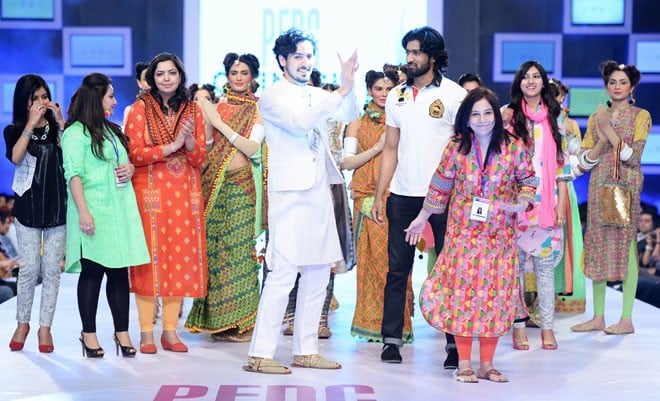
Waleed Zaman talks about taking Kayseria -- that shares space with sister concerns Bareeze, Chinyere and Rang Ja -- beyond textiles or commercial design

Waleed Zaman, Creative Director at Kayseria, has a bone to pick with anybody who lauds him as a textile guru. "Textile may intrinsically be our strong point but we’ve also been making inroads into ready-to-wear," he points out. "That cannot be ignored."
The fledgling Kayseria prêt line launched about one and a half years ago has proceeded to win customers with its very competitive prices – usually ranging below Rs 5000. It’s undeniable that the garments tend to veer towards ‘safe’ retail-friendly silhouettes Waleed admits to that and does plan to push that elusive fashion envelope further. So far, though, what has truly drawn customers to Kayseria aside from those miraculous prices is the fabric, in both stitched and unstitched versions.
This is only to be expected: Kayseria is part of the CEFAM group, most well-known as the strength behind the infamous Bareeze. People associate great quality and strong aesthetics with CEFAM. Fabric, simply, is their forte.
Prints a la mode
One has seen gorgeous printed fabric emerge from the Kayseria label: vivaciously colored stamps splattered all over tunics, architectural outlines on quirky, tiny waistcoats, summery Nasarpur-inspired white and blue color palettes, printed kites and florals heralding the spring season and the ever-sellable, eye-catching odes to truck-art. Most recently, the Delhi Pop line, showcased at the TDAP’s Aalishan Pakistan fashion show in Delhi paid ode to music icon Nazia Hassan through quirky stripes and geometric patterns.
"As a retail house, we have to focus on sales and we’ve noticed that experimental silhouettes in ready-to-wear don’t tend to sell well," observes Waleed. "Customers appreciate neat, pretty detailing on well-stitched tunics but an unconventionally fashioned cape may be appreciated but won’t bring in the sales. Similarly, sometimes we can’t resist adding birds to our prints but faces and animals generally don’t have strong retail value. This is why we stick to prints that are traditionally Pakistani and acceptable to all customers."
However, if it continues to pander just to conventions, Kayseria runs the risk of getting lost in the crowd of humdrum ready-to-wear brands. This is something that Waleed understands well. Khaadi has a Khaadi Khaas for its more avant-garde clientele and Sana Safinaz delves into sultry silks as well as regular cotton tunics – Kayseria certainly needs to diversify in order to maintain a fashion-savvy image.
"We’re bringing out a funkier line this winter while staying true to our signature conventional traditionalism," Waleed promises. "We have a capsule collection coming up, dedicated to Ustad Saif-ur-Rehman’s Naqqashi and an English print line inspired by the early 20th century artist Harry Wearne. There are some fun silhouettes, currently in production as well as our usual, very popular, line-ups of slinky capes, waistcoats and shawls."
Even as it dabbles in experimental waters, Kayseria’s chief competitors include sister-brands Chinyere and Rang Ja. Is there ever a conflict of interest within CEFAM with so many brands catering to more or less the same target customers? "No," says Waleed. "In fact, the competition within our corporation keeps us on our toes and drives us to be sharper with our retail as well as in our marketing strategies."
Festooning fashion weeks
Fashion wheels are a major cogwheel in Kayseria’s marketing mechanisms. Waleed himself claims to be media-shy and dwells in the background – although with his classic good looks and spot-on dress sense he could have easily be fashion’s favorite poster-boy. His brand, though, features very regularly at fashion weeks, the design team walking out on to the catwalk for the final bows.
"Kayseria is completely a team effort," explains Waleed. "I may be guiding my team but many of the inspirations are theirs."
Earlier this year, Fashion Pakistan Week (FPW) and the PFDC Sunsilk Fashion Week (PSFW) both featured Kayseria lineups in bright splashes of colours, with lawn fashioned onto saris, tunics and quirky fabric umbrellas. Come Spring 2014, the brand staged a fashion event in association with Garnier, aptly titled the ‘Colours of Spring’ festival. The very Basant-inspired Kayseria line was showcased at the event amidst kite-flying, local music and desi gol gappas and rasmalai stands. From the Mercedes Benz Fashion Week in Amsterdam to Aalishan Pakistan in India, the brand is now a regular feature on catwalks.
"Fashion shows serve as fabulous marketing tools," observes Waleed. "The images immediately filter onto social media, followed up by coverage in print and on television."
As somebody who showcases regularly in both Karachi and Lahore, which fashion week generates greater customer interest, FPW in Karachi or Lahore’s PSFW? "Both fashion weeks are extensively covered by the media but I feel that the Fashion Pakistan Council (FPC) is more flexible and understanding. At FPW, Kayseria is slotted within the main event, sharing the catwalk with prêt, luxury-pret and couture heavyweights. As a result, the show is better attended. The PFDC, in contrast, relegates us to the afternoon high-street timings. The media interest and audience attendance in these shows is generally low."
Regardless of where he shows, Waleed makes it a priority to follow fashion week outings with prompt stocking. "A customer in Australia may like something that she sees on a live stream at fashion week and immediately order it through our store," he says. Within Pakistan, of course, customers can just walk into any one of the Kayseria stores – the brand has a whopping 59 branches dotted about the country.
This, above all, is admirable. Waleed Zaman is carefully steering his brand forward, balancing a keen focus on business with improving design aesthetics. The fashion week showcases this year have been gorgeous – a few more of the same and we expect Kayseria to become a force to reckon with, nailing the market, dressing Pakistan better.